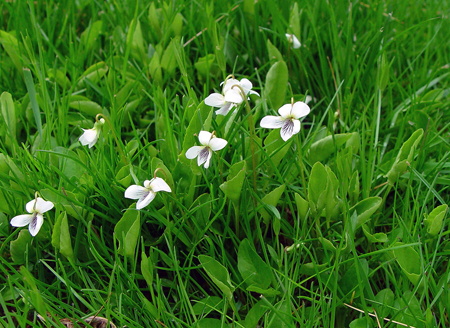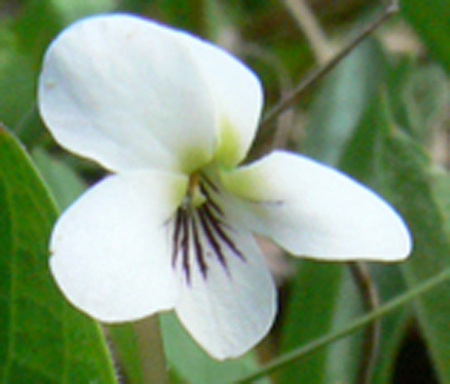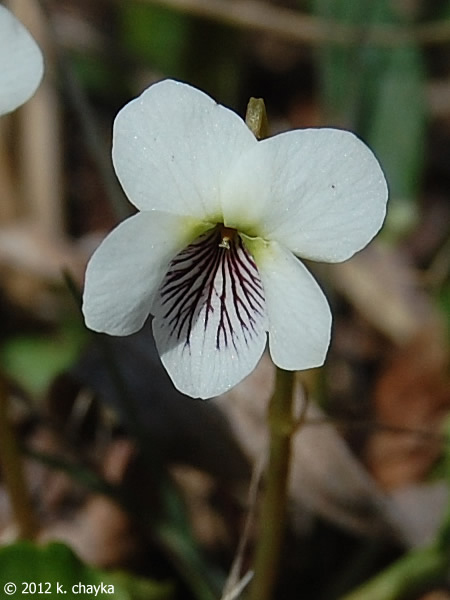Viola primulifolia L.
Common names:
Primrose-leaved Violet
Synonyms:
Viola primulifolia L., Sp. pl., ed. 1, 2: 934. 1753. TYPE: "Habitat in Sibiria, Virginia". Type: USA, [no locality], [no date], J. Clayton 470 (LECTOTYPE (designated by James Reveal in Jarvis (ed.), Order out of Chaos: 924. 2007): BM000042606, internet image!).
Viola primulifolia L. subsp. villosa (Eaton) N.H.Russell, Amer. Midl. Naturalist 54: 487. 1955; Viola primulifolia L. var. villosa Eaton, Man. bot., ed. 5: 443. 1829
Viola primulifolia L. f. subcordata Griscom, Rhodora 38: 50. 1936
Viola rugosa Small, Man. S. E. Fl.: 891. 1933
Viola reptabunda Greene, Leafl. bot. observ. 2(2): 94. 1910-1912
Viola senecionis Greene, Leafl. bot. observ. 2(2): 94. 1910-1912
Viola primulaefolia L. var. australis Pollard, Bot. Gaz. 26: 342. 1898
Viola primulifolia L. var. acuta (Bigelow) Torr. & A.Gray, Fl. N. Amer. 1(1): 139. 1838; Viola acuta Bigelow, Fl. Boston., ed. 2: 95. 1824
Viola primulifolia L. var. boscii Ging., in DC., Prodr. 1: 293. 1824
Viola primulifolia L. var. nuttalliiin DC., Prodr. 1: 293. 1824 Ging.
Viola primulifolia L. var. ovata Raf. ex Ging., in DC., Prodr. 1: 293. 1824
Viola radicans DC. ex Ging., in DC., Prod. 1: 297. 1824
Description:
Acaulescent stoloniferous perennials from slender rhizome, colonial from surficial stolons produced in summer, stolons bearing multiple nodes each with a leaf and cleistogamous capsule, ≤ 31 cm tall; foliage and peduncles green, or petioles and peduncles red-tinged, glabrous or occasionally hirsute; stipules free, finely glandular-fimbriate; leaves erect, leaf blades undivided, largest ≤ 62(85) × 35(50) mm, elliptic or ovate-lanceolate to ovate-triangular (rarely ovate), base broadly cuneate to shallowly cordate, margins crenate, eciliate, apex acute to narrowly rounded; chasmogamous peduncle held among or above the leaves; chasmogamous flower ≤ 10 mm; calyx glabrous, eciliate; lowest sepals lanceolate, acute; auricles short and entire, not elongating in fruit; corolla white, throat greenish-white; spur short-globose; all petals glabrous or lateral petals bearded with sparse to dense slightly clavate hairs; cleistogamous flowers produced after chasmogamous, peduncle erect and nearly or quite as long as petioles; capsule 5–11 mm, green drying light brown, unspotted or with fine red dots, glabrous; seeds (1.3)1.5–1.7 × 0.9–1.0 mm, dark brown, unspotted; 2n=24.
Similar species:
This species is sufficiently distinct in leaf morphology that it is liley to be confused only with two other long-leaved species in subsect. Stolonosae. It differs most obviously from Viola lanceolata and V. vittata, with which it occasionally grows and hybridizes, in its proportionally and physically broader leaf blades with broadly cuneate to shallowly cordate base. Its foliage is sometimes hirtellous, especially in populations in the middle and southern portions of its range, providing an additional difference from V. lanceolata, and produces leafy summer stolons with cleistogamous capsules, differing further from Viola vittata. It might be mistaken for V. blanda, but its leaves are erect, the basal lobes on plants with subcordate or shallowly cordate leaf blades are extremely short and divergent, pubescence (if present) is not confined to the upper surface of the leaf blades, and the unspotted cleistogamous capsule sits on a tall erect peduncle.
Ecology:
Moist somewhat acidic sandy, mucky or peaty soils of bogs, pocosins, wet savannas, meadows, edges of ponds, streams and marshes, and in and along borders of swamps.
Distribution:
Primarily Atlantic and Gulf Coastal Plains, rarer and sporadic on Piedmont and in Appalachian Mountains and Western Allegheny Plateau, NS to e. OH and s. IN, s. to FL, e. TX and e. OK; disjunct in the western Upper Great Lakes region in MI and MN (WI?).
Rarity:
State listed in IL, IN, OH; and NY [as V. primulifolia var. primulifolia].
Phenology:
Chasmogamous flower December–June, chasmogamous fruit January–June, cleistogamous fruit March–October.
Affinities:
This species belongs to the Acaulescent White Violet lineage, sect. Plagiostigma Godron, subsect. Stolonosae (Kupffer.) Kupffer.
Hybrids:
Hybridizes with V. cucullata (Bicknell 1904, Brainerd 1906b,1909, 1924, House 1924), V. lanceolata (Brainerd 1924, Russell 1955c), V. minuscula (Dowell 1910, Brainerd 1924, House 1924, Russell 1955c, Harvey Ballard pers. comm.), and V. vittata (Brainerd 1924, Russell 1955c, Ballard, pers. comm.). I have observed the hybrids between acaulescent white species and have found the features of chasmogamous flowers and foliage to be more or less precisely intermediate. All hybrids fail to reproduce by chasmogamous flowers and produce abortive cleistogamous capsules or normal capsules with a substantially reduced proportion of viable seeds. Russell and Bowen's (1960) and Russell's (1965) reports of hybridization with V. pedata were based on non-reproductive individuals of V. pedatavar. flabellata; in unpublished studies of broader sampling I rejected the hypothesis (see comments under V. pedata). Although fantastically rare, two different hybrids involving acaulescent blue and white violets have been reported; for information concerning evidence supporting the interpretation of parentage for V. cucullata × V. primulifolia, see the former species.
Comments:
Brainerd (1921b), Brainerd Baird (1942), Russell (1965), Strausbaugh and Core (1978), Swink and Wilhelm (1979), Gleason and Cronquist (1991), Ballard (2000), McKinney and Russell (2002), Haines et al. (2011), and Weakley et al. (2012) recognized this as a distinct species without infraspecific taxa. Fernald (1950) distinguished var. acuta (Bigelow) Torr. & A.Gray and var. villosa Eaton as well as the typical variety, Henry (1953a) reported V. primulifolia var. acuta, Russell (1955c) separated out subsp. villosa (Eaton) N.H.Russell and subsp. primulifolia, and Alexander distinguished var. villosa Eaton and f. subcordata Griscom from typical V. primulifolia. Ballard (1995) assigned all material intermediate between V. lanceolata and V. minuscula (then referred to V. macloskeyi) to V. ×primulifolia, confounding the predominately eastern and southeastern V. primulifolia with apparently sterile em>sublanceolata House (V. lanceolata × V. macloskeyi [= V. minuscula]) , as well as reportedly fertile populations in the western Upper Great Lakes region. Voss and Reznicek (2012) tentatively admitted V. primulifolia in Michigan, noting that this included many records representing the sterile hybrid V. ×sublanceolata and a few collections of apparently fertile plants in the Upper Peninsula. The species, as represented by populations in the Appalachian Mountains and adjacent uplands, and on the Atlantic and Gulf Coastal Plains, displays complex and incongruent variation patterns in leaf blade shape and foliage and peduncle indument. Generally, populations in the central Appalachians and on the Piedmont and the northern Atlantic Coastal Plain southward often (but not always) possess hirtellous foliage and peduncles, whereas populations to the north virtually always have glabrous foliage and peduncles. Over the last half-century, infraspecific categories have been abandoned, since assigning names of the various infraspecific taxa to specimens would become a fruitless and sometimes frustrating exercise. Plants resembling V. primulifolia have commonly been reported as such in the western Great Lakes region, but most have been found to represent the frequent hybrid V. lanceolata × V. minuscula (V. ×sublanceolata House). However, some populations in northern Michigan and in the Anoka Sand Plains of eastern Minnesota appear to reproduce at least by cleistogamous fruits, an event not duplicated by completely sterile (V. ×sublanceolata House. These are tentatively included in V. primulifolia pending further study on their evolutionary and taxonomic status.
Literature Cited:
Alexander, E. J. 1963. Violaceae. In Gleason, H. A., The new Britton and Brown illustrated flora of the northeastern United States and adjacent Canada. Hafner Publishing Co., Inc., New York, NY. 552-567.
Ballard Jr., H. E. 1995 ["1994"]. Violets of Michigan. Michigan Botanist 33: 131-199.
Ballard Jr., H. E. 2000. Violaceae. In Rhoads, A. (ed.). Flora of Pennsylvania. University of Pennsylvania Press, Philadelphia, PA. 700-710.
Bicknell, E. P. 1904. Three new violets from Long Island. Torreya 4: 129-132.
Brainerd, E. 1906b. Hybridism in the genus Viola,-II. Rhodora 8: 6–10.
Brainerd, E. 1909. Another hybrid between a white and a blue violet. Rhodora 11: 115-116.
Brainerd, E. 1921b. Violets of North America. Vermont Agricultural Experiment Station Bulletin 224: 1-172.
Brainerd, E. 1924. The natural violet hybrids of North America. Vermont Agricultural Experiment Station Bulletin 239: 1-205.
Brainerd Baird, V. 1942. Wild violets of North America. University of California Press, Berkeley, CA.
Dowell, P. 1910. The violets of Staten Island. Bulletin of the Torrey Botanical Club 37: 163-179.
Fernald, M. L. 1950. Violaceae. In Gray’s Manual of Botany, 8th ed. American Book Company, New York, NY. 1022-1042.
Gleason, H. A., and A. Cronquist. 1991. Violaceae. In Manual of vascular plants of northeastern United States and adjacent Canada, 2nd ed. New York Botanical Garden, Bronx, NY. 157-163.
Haines, A., E. Farnsworth, and G. Morrison. 2011. Violaceae. In Flora Novae Angliae. Yale University Press, New Haven, CT. 873-886.
Henry, L. K. 1953a. The Violaceae in western Pennsylvania. Castanea 18(2): 37-59.
House, H. D. 1924. Annotated list of the ferns and flowering plants of New York state. Family 83 Violaceae. New York State Museum Bulletin 254: 499-512.
Little, R. J., and L. E. McKinney. 2015. Violaceae. In Flora of North America: Cucurbitaceae to Droseraceae, 106. Oxford University Press, New York, NY.
McKinney, L. E., and N. H. Russell. 2002. Violaceae of the southeastern United States. Castanea 67: 369-379.
Russell, N. H. 1955c. The taxonomy of the acaulescent white violets. American Midland Naturalist 54: 481-494.
Russell, N. H. 1965. Violets (Viola) of the central and eastern United States: An introductory survey. Sida 2: 1-113.
Strausbaugh, P. D., and E. L. Core. 1978. Violaceae. In Flora of West Virginia, 2nd ed. Seneca Books, Inc., Morgantown, WV. 644-658.
Swink, F., and G. Wilhelm. 1979. Violaceae. In Plants of the Chicago region, 2nd ed. revised and expanded. Morton Arboretum, Lisle, IL. 384, 801-810.
Voss, E. G., and A. A. Reznicek. 2012. Violaceae. In Field manual of Michigan flora. The University of Michigan Press, Ann Arbor, MI. 913-922.
Weakley, A. S., J. C. Ludwig, and J. F. Townsend. 2012. Violaceae. In Flora of Virginia. BRIT Press, Fort Worth, TX. 963-975.

Chasmogamous flowering habit by Arthur Haines, "Go Botany" website, Native Plant Trust

Chasmogamous flowering habit by Bruce Sorrie

Chasmogamous flower front view by Arthur Haines, "Go Botany" website, Native Plant Trust

Chasmogamous flower front view by Bruce Sorrie

Chasmogamous flowering habit (CL fertile taxon in MN) by Peter M. Dziuk, "Minnesota Wildflowers" website

Cleistogamous fruiting habit (CL fertile taxon in MN) by Peter M. Dziuk, "Minnesota Wildflowers" website

Leaf (CL fertile taxon in MN) by Katy Chayka, "Minnesota Wildflowers" websiteLeaf by Katy Chayka, "Minnesota Wildflowers" website

Chasmogamous flower front view (CL fertile taxon in MN) by Katy Chayka, "Minnesota Wildflowers" website

Seeds (CL fertile taxon in MN) by Peter M. Dziuk, "Minnesota Wildflowers" website

Map by the Biota of North America Program